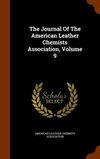Effect of Pigment-Acrylic Binder Ratio on the Surface and Physical Properties of Resin Finished Leather
IF 0.5
4区 工程技术
Q4 CHEMISTRY, APPLIED
Journal of The American Leather Chemists Association
Pub Date : 2024-01-02
DOI:10.34314/jalca.v119i1.8291
引用次数: 0
Abstract
The current study attempts to investigate the surface phenomenon and physical characteristics of leather finished with brown pigment and different types of acrylic binders. Using the contact angle measurements of three different liquids on the above finished leathers and films, the surface energy and work of adhesion were evaluated. The pigment to acrylic binder ratio (PABR) for best adhesion of finish film on the leather surface was optimized using the contact angle goniometer. Different types of acrylic binder films were coated and their surface behaviour was studied. The crust leather was coated with different types of pigment-acrylic binder (Very Soft, Soft and Medium Soft) finish formulations. The contact angle of both the acrylic films and the PABR finished leathers were measured against Water, Dimethyl sulfoxide (DMSO) and Hexadecane (HD). According to the study’s results, the surface properties of finished leather were directly related to the degree of wetting. The PABR was found to be effective at 1:3 for very soft binder, 1:2.5 for soft, 1:2 for medium soft binders due to higher contact angle and lower surface energy values (γsv). At 1:3 and 1:2.5, the contact angle of very soft and soft binder leather was 82.62° and 83.45° and for medium soft binder it was 82.67° at 1:2 ratio. The surface energy values of optimized PABR of very soft binder (1:3) was 28.29 (mN/M), soft binder (1:2.5) was 27.50 (mN/m) and medium soft binder (1:2) was 29.27 (mN/m). The optimized PABR work of adhesion values of very soft binder, soft binder and medium soft binder was 82.15 (mJm-2), 81.11 (mJm-2), 82.09 (mJm-2). In order to correlate the observed surface properties with leather finish properties, finished leathers were tested for finish adhesion, vamp flexing value, water vapour permeability, wet and dry rub fastness. According to the water vapour permeability, soft and medium binder showed good permeation due to the uncovering of nanopores. But the adhesion, grain crack resistance and grain smoothness were higher in the case of the soft binder. Overall leather properties divulges that the pigment to binder ratio and the type of binder plays an important role in surface properties of the finished leather. This study enables us to determine the optimal PABR for effective finish properties to meet the required leather standards for various usage, as well as better utilisation of finishing chemicals.颜料-丙烯酸粘合剂比例对树脂涂饰皮革表面和物理特性的影响
本研究试图调查使用棕色颜料和不同类型丙烯酸粘合剂涂饰的皮革的表面现象和物理特性。通过测量三种不同液体在上述涂饰皮革和薄膜上的接触角,评估了表面能和附着功。使用接触角测角仪优化了颜料与丙烯酸粘合剂的比率(PABR),以获得涂饰薄膜在皮革表面上的最佳粘附力。涂覆了不同类型的丙烯酸粘合剂薄膜,并对其表面行为进行了研究。用不同类型的颜料-丙烯酸粘合剂(极软、软和中软)涂饰配方涂覆硬皮。测量了丙烯酸薄膜和 PABR 涂饰皮革与水、二甲基亚砜(DMSO)和十六烷(HD)的接触角。研究结果表明,成品革的表面特性与润湿程度直接相关。由于接触角较大且表面能值(γsv)较低,PABR 在极软粘合剂为 1:3 时有效,在软粘合剂为 1:2.5 时有效,在中等软粘合剂为 1:2 时有效。在 1:3 和 1:2.5 的比例下,极柔软和柔软粘合剂皮革的接触角分别为 82.62° 和 83.45°,而在 1:2 的比例下,中等柔软粘合剂的接触角为 82.67°。极软粘合剂(1:3)的优化 PABR 表面能值为 28.29(mN/M),软粘合剂(1:2.5)为 27.50(mN/m),中软粘合剂(1:2)为 29.27(mN/m)。极软粘合剂、软粘合剂和中软粘合剂的优化 PABR 附着功值分别为 82.15 (mJm-2)、81.11 (mJm-2) 和 82.09 (mJm-2)。为了将观察到的表面特性与皮革的涂饰特性联系起来,对涂饰皮革的附着力、鞋面挠曲值、水蒸气渗透性、干湿摩擦牢度进行了测试。根据水蒸气渗透性,软质和中质粘合剂由于纳米孔的揭露而显示出良好的渗透性。但软质粘合剂的附着力、粒面抗裂性和粒面平滑度更高。皮革的整体特性表明,颜料与粘合剂的比例以及粘合剂的类型对成品革的表面特性起着重要作用。这项研究使我们能够确定最佳的 PABR,以获得有效的涂饰性能,满足各种用途所需的皮革标准,并更好地利用涂饰化学品。
本文章由计算机程序翻译,如有差异,请以英文原文为准。
求助全文
约1分钟内获得全文
求助全文
来源期刊

Journal of The American Leather Chemists Association
工程技术-材料科学:纺织
CiteScore
1.30
自引率
33.30%
发文量
29
审稿时长
3 months
期刊介绍:
The Journal of the American Leather Chemists Association publishes manuscripts on all aspects of leather science, engineering, technology, and economics, and will consider related subjects that address concerns of the industry. Examples: hide/skin quality or utilization, leather production methods/equipment, tanning materials/leather chemicals, new and improved leathers, collagen studies, leather by-products, impacts of changes in leather products industries, process efficiency, sustainability, regulatory, safety, environmental, tannery waste management and industry economics.
 求助内容:
求助内容: 应助结果提醒方式:
应助结果提醒方式:


